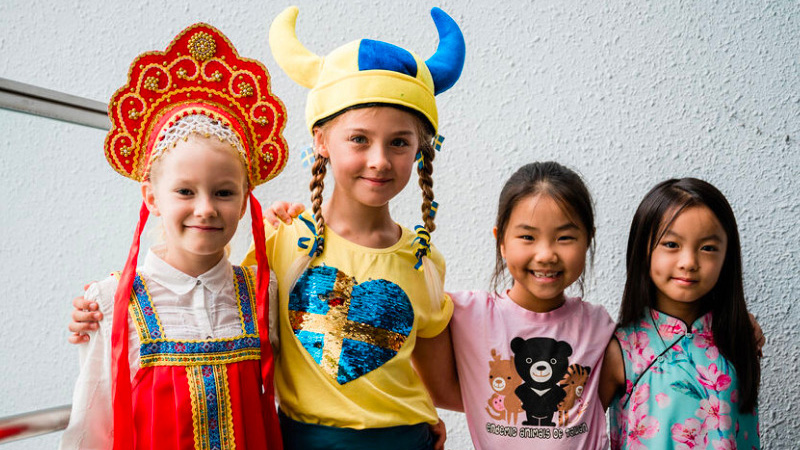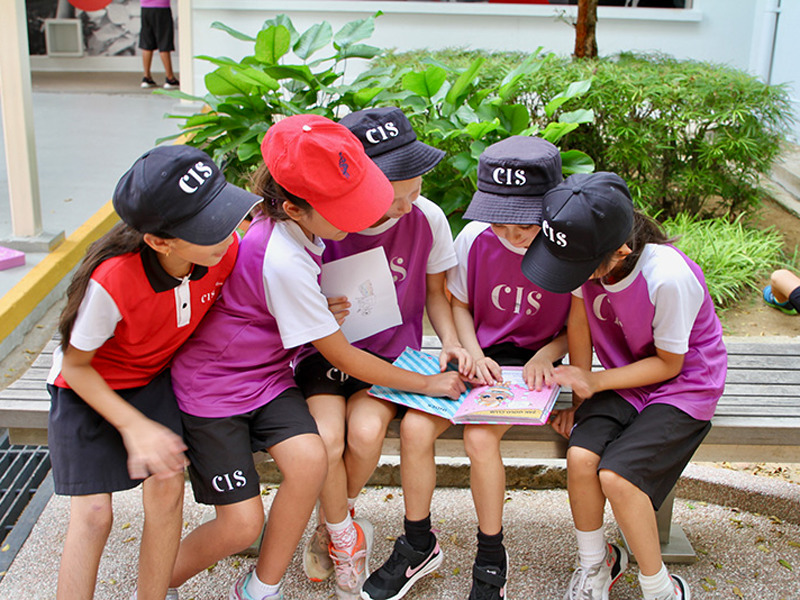[ad_1]
For many families, finding the right school is one of the most crucial decisions to make when moving to a new country. If you’re considering relocating to Singapore for your next expat post, the following guide is full of information and advice on international schools, including case studies of four schools, and interviews with others who’ve moved from Hong Kong to Singapore.
Singapore’s international schools
With Singapore being such a popular destination for expats from around the world to live and work, it’s no surprise to find a thriving international school scene. In fact, there are around 80 such schools; most of these offer a multicultural environment, with students from a diverse range of backgrounds and countries.
There’s a big variety when it comes to curriculum too. Some maintain a single-country programme, from the English National Curriculum to the Advanced Placement (US), to programmes from Japan, France, Germany, India and elsewhere. Others offer the globally recognised International Baccalaureate programme. In fact, approximately half the international schools in Singapore are IB schools, with as many as 30 offering the IB Diploma Programme (IBDP), which is known for being well-rounded and rigorous. At some schools, you’ll find a mix of these curriculums.

Finding a spot!
Given the strength and reputation of the school system in Singapore, some parents in Hong Kong worry that there might not be any places for their kids. According to Ruth Benny, the founder of Top Schools, this isn’t really the case.
“A few schools are always in high demand and are extremely competitive, so in these schools I wouldn’t say it’s easy to find a place,” she says. “However, for most international schools in Singapore we have had no issues in finding spaces for the Hong Kong families relocating there. Similar to Mainland China but different to Hong Kong, local Singaporean citizens are generally not allowed to attend international schools so the schools do rely on expats to fill their seats.”
Another factor is the growth in the number of schools in Singapore. New international schools seem to open every year – in 2020 alone, four new ones opened their doors. And while local education is also an option, with fees considerably lower than their international counterparts, there are some fairly strict admission obstacles for expats to get around. It’s really about finding the best fit. And that means doing your research and asking lots of questions. If you’re not sure what to ask, read on!
Key factors to consider when shortlisting Singapore schools
There are some obvious topics that parents will have questions about when starting their research. Fees is one. Common queries include, “How much are they?” “Do they increase every year?” and “Are they all-inclusive?”
A school’s age and reputation is another. Many families want to know how long a school has been around, where the teachers are from and how experienced they are.
For a deeper dive into whether or not a school might be right for you and your family, you could also consider the following checklist of questions.
10 things to ask
#1 What is the curriculum, and will it suit my child’s educational needs and the future plans of our family? Finding the right fit with the curriculum can help minimise the impact of moving country and school. At the same time, Ruth Benny from Top Schools says it shouldn’t be the sole factor in a decision. “It’s important not to prioritise or eliminate schools merely on the basis of curriculum – at least not in the early stages or for young children. Each school has its own unique characteristics and curriculum is rarely the most important.”
#2 Where is the school located? Is it a manageable commute to the campus from home? What are public transport links like?
#3 What are class sizes like, and is there a high teacher-to-child ratio?
#4 What is the language programme at the school? Is there a compulsory second language, and is this an experience that will benefit my child?
#5 What kind of extracurricular opportunities are offered as a balance to my child’s academic studies and to help widen his or her educational experience?
#6 Can parents get involved at the school? This can be a great way to meet new people and become a part of the community.
#7 What are the school facilities like for educational, sporting and cultural pursuits?
#8 What kinds of school excursions are offered? With COVID restrictions easing, for instance, might there be opportunities for visits to foreign countries for volunteering and community engagement? What about excursions on a local level?
#9 Does the term calendar vary from our previous school in Hong Kong? When does school start, and when are the holidays?
#10 What are the school’s methods of communication with parents? Can we follow newsletters and social media outlets to see our children’s learning experiences and hear school news?
A snapshot of some Singapore schools
Here’s a look at four different international schools in Singapore, including a mix of new and old, small and large, and with educational backgrounds ranging from Australian to Canadian, British and American – including feedback from the schools themselves on curriculum, languages and more.
Australian International School (AIS)
Founded: 1993
Number of students: 2,500
Nationalities: Over 50
Grades: Infant care to Year 12
Dates: Southern Hemisphere academic calendar, January-December
Location: In a residential neighbourhood 10 minutes by car from Orchard Road, and close to Lorong Chuan MRT station, connecting the rest of Singapore
A word from the team
What curriculums are taught at AIS?
Our students enjoy an international education underpinned by the standards of the Australian Curriculum. To provide a clear pathway from K to Year 12 and beyond, we employ a range of globally respected curriculums, beginning with the IB Primary Years Programme from Preschool to Year 5, followed by the Australian Curriculum for Years 6 to 8, the Cambridge IGCSE for Years 9 and 10, and the Higher School Certificate (HSC) or IB Diploma Programme (IBDP) for Years 11 and 12.
Are there opportunities for learning Mandarin?
Chinese begins in Nursery, taught by a Chinese specialist teacher who leads with games, stories and songs. It continues through to Year 5, with daily classes spilt into different levels according to proficiency. Secondary students can enrol in Mandarin, French, or Spanish, all taught by specialists.
Mandarin-speaking students also take their language exams in their own language at the same level as English-speaking students, providing excellent continuity and readiness for higher education either in their own country or elsewhere, as all students are also required to study English. Our Heritage Speakers Program offers an entry to learning Mandarin as an additional language for students who have a Mandarin background but aren’t yet fluent.
What support do you offer to families relocating to Singapore?
The school’s Parents Association (AISPA) has the primary objective of promoting community spirit at AIS, both for newcomers and long-term families. In addition to events held throughout the year, we’ll help you and your family settle into school and life in Singapore, providing information, resources and friendship. We also host monthly online Open Houses, where you can meet and chat with the AIS leadership team and learn more about the school.
Canadian International School
Founded: 1994
Number of students: 3,100
Nationalities: Over 70
Grades: Nursery to Grade 12
Dates: August to June
Location: Two campuses in Singapore; Lakeside campus in the west and Tanjong Katong in the east, both close to transport links
A word from the team
What curriculums are taught at the school?
We are an authorised IB World School, and one of the few schools in Singapore to offer all three IB programmes: the IB PYP, IB MYP and IBDP. Our curriculum is benchmarked against national global curricula globally, allowing students to transition to another school, if and when required, or graduate and be admitted to leading universities around the world.
Are there opportunities for learning Mandarin?
Students have a choice of two language pathways: the English programme (with daily language lessons) or a bilingual programme (Chinese or French). CIS’s world-class Chinese-English bilingual programme was among the first offered in Singapore by an international school. Students attend classes in English one day and Chinese the next, ensuring equal exposure to both languages. We currently have 47 bilingual classes, with a specific pathway designed for students to maintain their Chinese in Secondary School and the MYP. Our wide range of resources includes a collection of over 8,000 Chinese fiction books.
What support do you offer to families relocating to Singapore?
From supporting families in submitting applications and answering specific questions about our school, facilities and programmes, we are with families every step of the way. From their first contact with us, right up to making sure their first day of school is a smooth and happy experience, we strive to make families feel the genuine warmth and care of the whole CIS community.
Brighton College (Singapore)
Founded: 2020 (Brighton’s UK founding school dates back to 1845)
Number of students: 180
Nationalities: 24
Grades: Pre-Nursery to Year 6, expanding to Year 8 soon
Dates: August to July
Location: In Lorong Chuan, a mostly residential area with good connectivity to Orchard Road and the CBD
A word from the team
What curriculum is taught at the school?
We offer the academically rigorous English National Curriculum. It promotes a problem-solving, analytical approach, that encourages an outward-looking perspective, and social responsibility and engagement; it empowers our pupils to lead, shape and change their world. Brighton pupils are curious; they enjoy discovering and they feel confident and resilient enough to try and to learn from their attempts. The strong foundation for learning is supported by a school culture driven by our three key pillars of curiosity, confidence and kindness.
Are there opportunities for learning Mandarin?
Yes, there are opportunities to learn Mandarin, from exposure to story-telling and weekly lessons in Pre-prep, to structured Mandarin lessons from Year 1 onwards. From Year 3, French is included as part of the weekly timetable as well.
What support do you offer to families relocating to Singapore?
At Brighton, we understand that choosing a school is possibly one of the most important choices you face, and that a move from overseas can add additional pressure. So we work closely with relocating families throughout the admissions process and provide advice on other aspects of their move as needed.
Stamford American International School (SAIS)
Founded: 2009
Number of students: 2,800 students across two campuses
Nationalities: 75
Grades: Infant care to Grade 12
Dates: August to June
Location: Two centrally located campuses – Woodleigh campus (6-18 years) and the Early Learning Village (2 months – 6 years), both within walking distance to the MRT
A word from the team
What curriculums are taught at the school?
As an IB World School, Stamford offers the IB PYP, IB MYP and IBDP. We’re also the first and only school in Singapore to combine Advanced Placement (AP), IBDP and Business and Technical Education Council (BTEC) Diploma curricula within a US-accredited high school diploma. These multiple pathways are designed to inspire students to create their unique future.
Are there opportunities for learning Mandarin?
Yes, as part of our World Language Program, we offer daily instruction in English, Mandarin and Spanish. Every child in our Early Learning Village and Elementary School receives daily Mandarin lessons. In Secondary School, these classes become more intensive 80-minute sessions every other day. Progress is measured through 7 levels for Mandarin. We also offer an English/Mandarin Bilingual Program at no extra cost for students who are keen on dedicating more time and effort to learning a second language.
What support do you offer to families relocating to Singapore?
More than half of our new families each year come from other countries. From the application process to the first day at school and beyond, we have programs aimed at providing seamless transitions. Relocating families can reach out to our parent community country ambassadors, connect with a buddy family or a buddy student, and join our webinar to get advice from counsellors.
Hear from families who’ve relocated to Singapore
Two families share their experiences relocating from Hong Kong to Singapore and starting their children in a new school in Singapore.
Yuen Chin Wong and family
Yuen Chin Wong moved to Singapore in 2021; the family lives on the east side of the island; before that, they were in the New Territories in Hong Kong. “My son previously studied at York International Kindergarten in HK, in 2019 and 2020; he’s now been at the Canadian International School (CIS) in Singapore for over a year.”
The family transitioned smoothly to their new school environment. “While it’s obviously different for all kids, mine adapted very well,” says Yuen Chin. “I talked to him about how CIS looks, and I showed a video before the first day; but he’s the type who likes to go to school and learn and play, so it was easy.”
“We also found the CIS Tanjong Katong campus to have a very warm feeling; the kids behave well, they greet each other in the morning and so on. I think the school has a good way of guiding kids to learn while also giving them their freedom.”
The family has adapted to Singapore well too. They appreciate the safety aspect, and also the greenery, including all the outdoor parks. “What we enjoy most are the spacious places for kids to run around. The transportation makes everything quite accessible too. We lived right near a station in Hong Kong, and it’s the same here – we’re close to a station, so it’s easy to reach anywhere in Singapore.”
Anna and Harry
Anna is a brand new arrival in Singapore; she’s the mother of Harry, who started at Stamford American International School (SAIS) in mid-April of 2022; Harry is in Grade 2 of the school’s Bilingual Program. The family was previously based in Kau To Shan – Harry attended the Canadian International School of Hong Kong (CDNIS); now they’re living close to the ocean at Singapore’s Sentosa Cove.
The family’s main reason for relocating from Hong Kong to Singapore, according to Anna, was to avoid too many disruptions to Harry’s study and wellbeing during the pandemic. “Singapore’s transparent and steady policies in handling the transition to endemic give us a lot of confidence in calling it our home now,” she adds. They’d also travelled to Singapore many times prior to COVID, so they were familiar with it. They liked both its cultural similarities with HK and the fact that it’s relatively close.
All of this made for an easy and convenient transition – as did their experience at SAIS. “We’re so grateful that Harry has been given the opportunity to join Stamford, and particularly the Bilingual Program,” says Anna. “We are very lucky to have encountered SAIS and met the admissions team and staff – they provided so much time and advice to our family in the enrolment process. We’re confident that we’ve made a great decision for our child’s education.”
Want to know more about schools in Singapore?
The Expat Living Singapore website has comprehensive guides to preschools and schools in Singapore, including views and reviews from families, and features on campus facilities, extracurricular activities, specific subjects, sports programmes and more. Visit expatliving.sg/living-in-singapore/schools.
Written in collaboration with Singapore Global Network, a 70,000-strong international community of professionals, families and friends who share a common connection to Singapore.
Like this? Read more features in our Living in Hong Kong section.
[ad_2]















